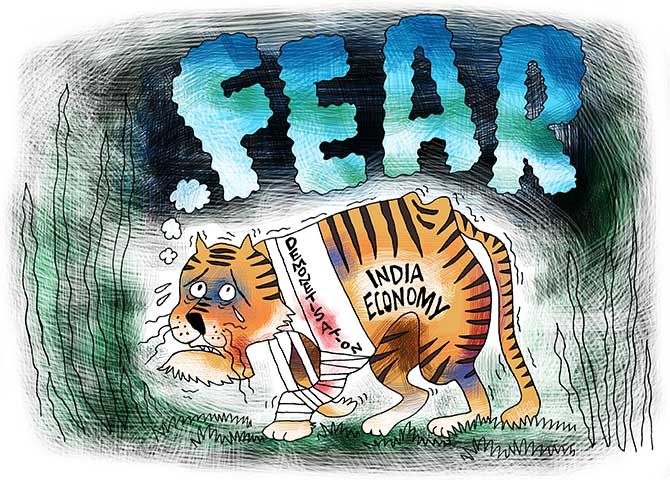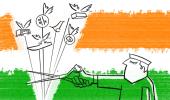Economist Deepak Nayyar says economic openness, while necessary, is not sufficient, and is conducive to development only when combined with industrial policy.
Illustration: Uttam Ghosh/Rediff.com

The Singaporean-South Korean model of carrot-and-stick to implement policies cannot be replicated elsewhere in Asia, and heterodox or unorthodox economic policies will be more effective for latecomers to development, noted economist Deepak Nayyar writes in a new book.
In his book, 'Resurgent Asia: Diversity in Development', Nayyar writes that Asia, the poorest continent in the world barely a half-century ago, after being ravaged by colonialism, is set to regain its dominant position in the global architecture, both financially and politically, and could account for more than one-half of world income and more than half of the people on Earth.
His policy prescriptions include learning and unlearning from experience as policies are means not ends.
"For latecomers to development, heterodox or unorthodox economic policies - in trade, industry, and macro-management - are more effective than orthodox policies," he writes.
"Efficient markets and effective governments, together, adapting to each other as time and circumstances change, provide the way forward in development."
He says economic openness, while necessary, is not sufficient, and is conducive to development only when combined with industrial policy.
He also prescribed social opportunities for people, through the public provision of education and healthcare, which improve wellbeing and the economic development of countries reinforce each other in a virtuous circle.
The developmental states in South Korea, Taiwan and Singapore coordinated policies across sectors over time in pursuit of national development objectives, using the carrot-and-stick to implement their agenda, and were able to become industrialised nations in just 50 years.
China and Vietnam have followed the same path.
"It is not possible to replicate these states elsewhere in Asia," Nayyar writes.
"But other countries did manage to evolve some institutional arrangements, even if less effective, that were conducive to industrialization and development. In some of these countries, the institutionalised checks-and-balances of political democracies were crucial to making governments more development-oriented and people-friendly."
In the book, Nayyar writes that despite wide diversity among Asian countries, there are common discernible patterns.
Chief among them was the fact that economic growth drove development; rising investment and savings rates combined with the spread of education were the underlying factors, and growth was driven by rapid industrialisation, often export-led, associated with structural changes in the composition of output and employment.
It was supported by coordinated economic policies, heterodox or unorthodox wherever and whenever necessary, across sectors, and over time.
"The rise of Asia represents the beginnings of a shift in the balance of economic power in the world and some erosion in the political hegemony of the West.
“The future will be shaped partly by how Asia exploits the opportunities and meets the challenges and partly by how the difficult economic and political conjuncture in the world unfolds," the book says.
"Yet, it is plausible to suggest that circa 2050, a century after the end of colonial rule, Asia will account for more than one-half of world income and will be home to more than one-half the people on Earth.
“It will thus have an economic and political significance in the world that would have been difficult to imagine fifty years ago, even if it was the reality in 1820," writes Nayyar.
Nayyar is a former vice-chancellor of Delhi University and Emeritus Professor of economics at Jawaharlal Nehru University.
He is also a former Distinguished University Professor of Economics, New School for Social Research, New York and is currently serving as an independent director on the Board of Directors of Press Trust of India.
The deep pessimism about Asia's economic prospects, voiced by Nobel laureate Gunnar Myrdal in his book 'Asian Drama', was widespread in 1970 when its demographic and social indicators of development, among the worst anywhere, epitomised its underdevelopment.
In the half-century since then, Asia has witnessed a profound transformation in terms of the economic progress of nations and living conditions of people.
By 2016, it accounted for 30 per cent of world income, 40 per cent of world manufacturing, and over one-third of world trade, while its income per capita converged towards the world average.
This transformation was unequal across countries and between people. Still, Asia's economic transformation in this short time-span is almost unprecedented in history.
'Resurgent Asia' considers differences in initial conditions, highlights turning points in economic performance, assesses how processes of change were managed or mismanaged, discusses the influence of development strategies and economic reforms, examines changes in engagement with the world economy, explores the role of governments and politics, and analyses the factors underlying successes, failures, or mixed-outcomes in development.
It is essential to recognise the diversity of Asia. There are marked differences between countries in geographical size, embedded histories, colonial legacies, nationalist movements, initial conditions, natural resource endowments, population size, income levels and political systems.
The reliance on markets and the degree of openness in economies varied greatly across countries and over time.
The politics too ranged widely from authoritarian regimes or oligarchies to political democracies.
So did ideologies, from communism to state capitalism and capitalism.
Development outcomes differed across space and over time.
There were different paths to development because there were no universal solutions, magic wands, or silver bullets.












 © 2025
© 2025